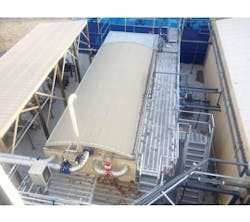About the author: Dwain Wilson is director of process operations for ADI Systems. Wilson can be reached at [email protected] or 506.451.7427.
The Kellogg Co. is a well-known cereal company and the second largest producer of cookies, crackers and savory snacks. It also produces frozen foods. The brand that began more than 100 years ago with only 44 employees has grown to become a household name with consumers in more than 180 countries.
Wastewater Treatment Upgrade
The Kellogg Co. manufactures products in 18 countries. Its Pikeville Plant (formerly Mountaintop Baking) located in Kimper, Ky., has been working with ADI Systems Inc., a global industrial wastewater treatment and waste-to-energy solutions company, for almost 15 years.
A production expansion in 1999 and 2000 created the need for Pikeville Plant to upgrade its wastewater treatment system. ADI Systems was awarded a design-build contract to complete the upgrade, which included an ADI-Hybrid anaerobic reactor followed by an ADI-SBR (sequencing batch reactor).
Kellogg Co.’s success necessitated further upgrades to the wastewater treatment system at the plant in order to handle the increased flow and organic loads from its food processing operations.
Stricter environmental regulations meant that the plant also was required to produce a higher-quality effluent. Because the Kellogg Co. is committed to the environment and the community, it wanted to comply with these regulations to remain a responsible corporation. The company wanted to partner with a wastewater treatment provider that could help its Pikeville Plant treat its wastewater before discharging it to a local stream.
Anaerobic Pretreatment & Aerobic Polishing
ADI Systems and Pikeville Plant once again partnered to address the subject of wastewater treatment. Ultimately, the Pikeville Plant decided to upgrade its existing anaerobic and aerobic wastewater treatment facility to an ADI-AnMBR (anaerobic membrane bioreactor) and an ADI-MBR (membrane bioreactor) system. The upgraded wastewater treatment system will reduce the company’s operating and maintenance costs and allow for a 25% increase in design flow and 44% increase in design organic load.
The upgraded system includes anaerobic pretreatment complete with a continuous stirred-tank reactor and an MBR tank. This is followed by an aerobic polishing system, which consists of a pre-aeration tank and an MBR tank. The AnMBR and MBR tanks are housed in a single, partitioned modular tank.
ADI Systems designed the ADI-AnMBR and ADI-MBR system and effectively managed the project to allow for quick installation. Part of this strategy involved reusing some of the existing equipment on site, thereby helping Pikeville Plant save money and waste. ADI Systems’ project management strategy meant that installing the new treatment system did not curtail production, so the plant was able to remain in operation throughout the construction and transition of the upgrade project.
The Pikeville Plant’s new wastewater design flow is 25,000 gal per day (gpd), which includes the 5,000 gpd of sanitary flow that is sent directly to the aerobic system. The flow has a design organic load of 7,200-lb chemical oxygen demand (COD) per day and an average design COD concentration of 34,500 mg/L. The wastewater treatment plant fits in an area of roughly 10,200 sq ft.
By upgrading its wastewater treatment system, the Kellogg Co. Pikeville Plant has improved its existing anaerobic and aerobic treatment facility so that it can produce a quality effluent—even after multiple production increases.
The AnMBR process provides effective anaerobic digestion of the plant’s wastewater, producing a low-effluent COD and a negligible total suspended solids (TSS) concentration. The aerobic MBR system polishes the AnMBR effluent, then a series of chlorination and dechlorination tanks provide disinfection for the MBR effluent.
The upgraded system has demonstrated an overall COD removal of greater than 99.3% and an average final effluent COD concentration of 83 mg/L, biochemical oxygen demand of less than 5 mg/L and negligible TSS (less than 1 mg/L). Other parameters such as fats, oils, grease, dissolved oxygen, ammonia nitrogen, E. coli, residual chlorine, etc., all meet strict discharge limits, allowing for the final effluent to be discharged directly to a local creek. McCoy & McCoy Laboratories monitors the final effluent quality and reports the results on a monthly basis.
Biogas, a byproduct of anaerobic digestion, currently is burned in a flare with future plans to use a portion of it in the wastewater treatment plant’s boiler to offset natural gas costs.
Pikeville Plant now also is able to treat waste jams, which previously were handled offsite. Currently, approximately 10 totes of jam waste per week are treated in the AnMBR system. This has resulted in more cost savings, helping to justify the installation of the new wastewater treatment system.
Download: Here
